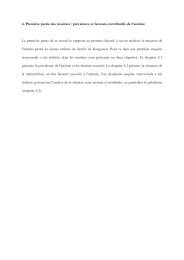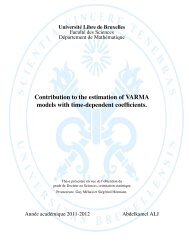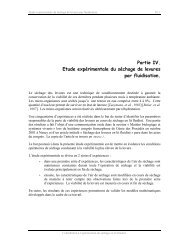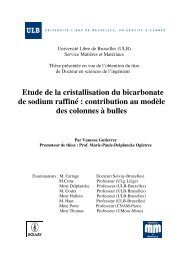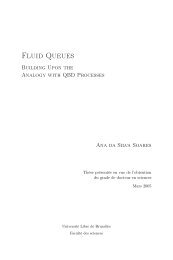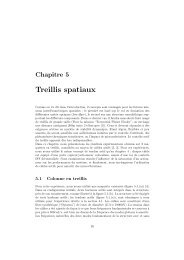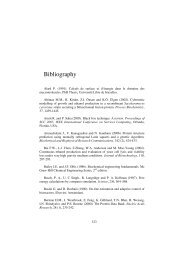Diapositive 1 - de l'Université libre de Bruxelles
Diapositive 1 - de l'Université libre de Bruxelles
Diapositive 1 - de l'Université libre de Bruxelles
Create successful ePaper yourself
Turn your PDF publications into a flip-book with our unique Google optimized e-Paper software.
Chapitre IIpositive temperature effect on crystal growth rate, which in turn controls strontiumincorporation (Rickaby et al 2002, Lorrain et al 2005, Carré et al 2006, Kisakürek et al2008). The effect of growth rate on skeletal Sr/Ca probably also explains the lower valuesof skeletal Sr/Ca observed in adult field specimen compared to those of aquarium grownjuveniles. In<strong>de</strong>ed, aquarium grown sea urchins were fed ad libitum while field collectedspecimens are frequently food limited. The skeletal growth rate effect is usually attributedto a faster and less efficient discrimination of calcium ions against strontium ions. Puretemperature effects can also be due to the increase in seawater supersaturation withtemperature (Morse & Mackenzie 1990), which results in an increased Sr incorporation ininorganic calcites linked to a faster crystal growth (Wasylenki et al 2005). The skeletalSr/Ca ratio was negatively linked to salinity. This observation is antagonist to the resultsof Borremans et al (2009), who reported a very clear positive relation between thesevariables in a starfish. However, the observed effect is weak and encompasses a veryrestricted salinity range. Further research is clearly nee<strong>de</strong>d to <strong>de</strong>termine the factorscontrolling the Sr/Ca ratio in the echino<strong>de</strong>rm skeleton. In particular, the involvement ofthe initial ACC in strontium incorporation <strong>de</strong>serves attention.Conclusion. Despite the large interindividual variations observed in this study, we wereable to show that temperature significantly controlled the skeletal Mg/Ca ratio in P.lividus and this effect was not due to growth rate as previously suggested. At highertemperatures, the relation showed a plateau, which limits the use of Mg/Ca ratio inP.lividus test as a temperature proxy to the lower temperatures. This plateau is postulatedas a si<strong>de</strong> effect related to properties of the organic matrix of mineralization incorporatedduring the carbonate precipitation. The modulation of the synthesis of Asp-rich proteins isa potential controlling factor. Because this saturation process is likely to occur atcontrasted temperature thresholds according to species, any temperature correction to beapplied to use the skeletal Mg/Ca ratio as a proxy of seawater Mg/Ca ratio (see Ries2004) has to be specific. In relation with climate change, the same saturation process canbe an adaptative feature for sea urchins because the skeletal Mg/Ca ratio and consequentsolubility is expected not to increase infinitely with temperature.AcknowledgementsB. David and two anonymous reviewers are acknowledged for their critical reading of themanuscript and fruitful suggestions. The authors wish to thanks Ph. Pernet, J. Navez, L.59



